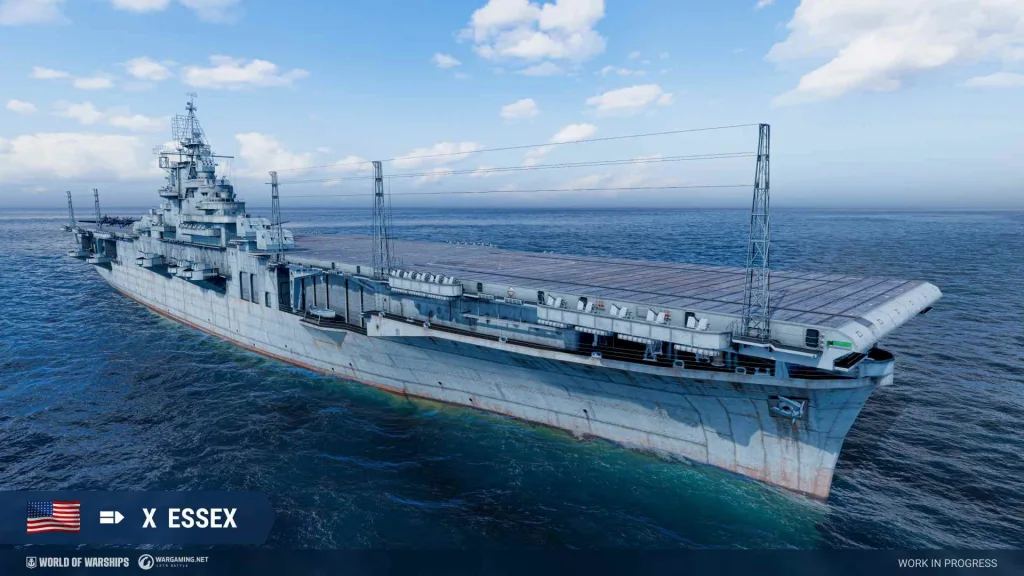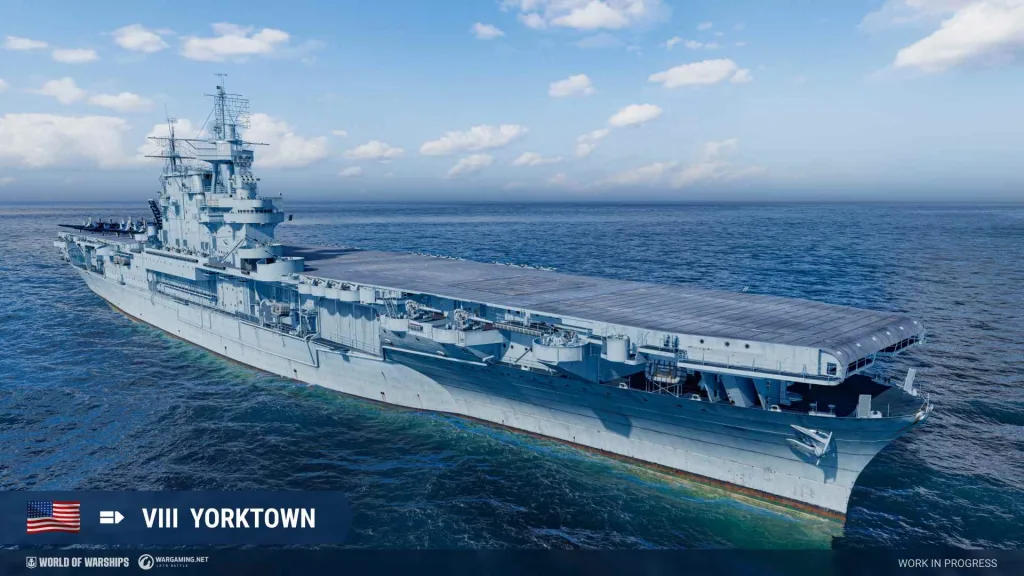American aircraft carriers Essex and Yorktown will be added to the Tech Tree in the future. Independence, a Tier VI aircraft carrier, will also enter testing.
New carriers have:
- Lesser attacking potential
- Yorktown and Essex have access to one standard squadron (torpedo bombers) and two tactical squadrons (attack aircraft and dive bombers) with jet-assisted take-off.
- Torpedo bombers need less time to reach the optimal spread when dropping torpedoes. single torpedo has a relatively low damage, but compensated by the high number of torpedoes and their above-average speed.
- Attack aircraft uses HE-rockets with high penetration and fire chance. the number of rockets per payload is relatively low.
- Dive bombers have a relatively low penetration and fire chance, but there are numerous bombs per payload.
- Both tactical squadrons can provide cover, using the Smoke Curtain Generator consumable that was introduced in Concealed Maneuvers.
- These ships can call for a Patrol Fighter that arrives much faster, compared to most carriers, however, its spotting range is relatively low. These fighters take more of a defensive and interceptive role.


Le portaerei americane Essex e Yorktown verranno aggiunte all’Albero tecnologico in futuro. Anche la Independence, una portaerei di livello VI, entrerà in fase di test.
Le nuove portaerei hanno:
- Potenziale di attacco minore
- Yorktown e l’Essex hanno accesso a uno squadrone standard (siluranti) e due squadroni tattici (aerei d’attacco e bombardieri in picchiata) con decollo assistito da jet.
- Gli aerosiluranti impiegano meno tempo per raggiungere la diffusione ottimale quando sganciano i siluri. un singolo siluro ha un danno relativamente basso, ma compensato dall’elevato numero di siluri e dalla loro velocità superiore alla media.
- Gli aerei d’attacco utilizzano razzi HE con elevata penetrazione e probabilità di fuoco. il numero di razzi per carico utile è relativamente basso.
- I bombardieri in picchiata hanno una probabilità di penetrazione e di fuoco relativamente bassa, ma ci sono numerose bombe per carico utile.
- Entrambi gli squadroni tattici possono fornire copertura, utilizzando il consumabile Generatore di cortine fumogene introdotto in Manovre nascoste.
- Queste navi possono richiedere un caccia di pattuglia che arriva molto più velocemente rispetto alla maggior parte delle portaerei, tuttavia il suo raggio di avvistamento è relativamente basso. Questi combattenti assumono più un ruolo difensivo e di intercettazione.
Yorktown and Essex – full preliminary stats
American aircraft carrier Yorktown, Tier VIII
Hit points – 50100. Plating – 19 mm.
Torpedo protection – 28 %.
Airstrike (DC):
Reload time – 25.0 s. Available flights – 1. Number of Aircraft in Attacking Flight – 1. Maximum range – 7.0 km. Number of Bombs in Payload – 1. Maximum bomb damage – 4200.0.
Secondary Armament:
8×1 127.0 mm, range – 4.5 km.
Maximum HE shell damage – 1800. Chance to cause fire – 5%. HE initial velocity – 792 m/s
AA defense: 6×4 40.0 mm., 3×2 40.0 mm., 8×1 127.0 mm., 50×1 20.0 mm.
AA defense short-range: continuous damage per second – 375, hit probability – 95 %, action zone – 2.0 km;
AA defense mid-range: continuous damage per second – 224, hit probability – 100 %, action zone – 3.5 km;
AA defense long-range: continuous damage per second – 77, hit probability – 100 %, action zone – 5.8 km;
Number of explosions in a salvo – 4, damage within an explosion – 1400, action zone 3.5 – 5.8 km.
Maximum speed – 32.5 kt. Turning circle radius – 1070 m. Rudder shift time – 12.4 s. Surface detectability – 13.0 km. Air detectability – 10.2 km. Detectability after firing main guns in smoke – 0.0 km.
Available consumables:
1 slot – Damage Control Party (Duration time 60 s; Reload time 90 s; Equipment is unlimited)
2 slot – Fighter (Duration time 600 s; Fighters 4; Action radius 3 km; Reload time 40 s; Charges 4)
Aircraft:
Attack aircraft
Hit points – 1390, cruising speed – 169.0 knots, maximum speed – 209.0 knots, size of attacking flight – 5, aircraft per squadron – 5, aircraft restoration time – 105 s, detectability range – 10.0 km, number of aircraft on deck – 5.
Rockets in payload – 2, maximum rocket damage – 5400, armor penetration – 68 mm, chance to cause fire – 33 %.
Torpedo bombers
Hit points – 1950, cruising speed – 126.0 knots, maximum speed – 161.0 knots, size of attacking flight – 2, aircraft per squadron – 8, aircraft restoration time – 93 s, detectability range – 10.0 km, number of aircraft on deck – 16.
Torpedoes in payload – 2, maximum torpedo damage – 5067, torpedo speed – 43.0 knots, torpedo range – 3.5 km, torpedo arming distance 577 m.
Dive bombers
Hit points – 2630, cruising speed – 125.0 knots, maximum speed – 160.0 knots, size of attacking flight – 6, aircraft per squadron – 6, aircraft restoration time – 125 s, detectability range – 10.0 km, number of aircraft on deck – 6.
Bombs in payload – 2, bomb type – HE, maximum bomb damage – 6200.0, armor penetration – 42 mm, chance to cause fire – 35 %.
American aircraft carrier Essex, Tier X
Hit points – 59500. Plating – 19 mm.
Torpedo protection – 34 %.
Airstrike (DC):
Reload time – 25.0 s. Available flights – 1. Number of Aircraft in Attacking Flight – 1. Maximum range – 8.0 km. Number of Bombs in Payload – 1. Maximum bomb damage – 4900.0.
Secondary Armament:
4×1 127.0 mm, range – 5.0 km.
Maximum HE shell damage – 1800. Chance to cause fire – 5%. HE initial velocity – 792 m/s
4×2 127.0 mm, range – 5.0 km.
Maximum HE shell damage – 1800. Chance to cause fire – 5%. HE initial velocity – 792 m/s
AA defense: 4×2 127.0 mm., 17×4 40.0 mm., 4×1 127.0 mm., 56×1 20.0 mm.
AA defense short-range: continuous damage per second – 396, hit probability – 95 %, action zone – 2.0 km;
AA defense mid-range: continuous damage per second – 441, hit probability – 100 %, action zone – 3.5 km;
AA defense long-range: continuous damage per second – 105, hit probability – 100 %, action zone – 5.8 km;
Number of explosions in a salvo – 5, damage within an explosion – 1610, action zone 3.5 – 5.8 km.
Maximum speed – 33.0 kt. Turning circle radius – 1120 m. Rudder shift time – 13.9 s. Surface detectability – 13.5 km. Air detectability – 10.7 km. Detectability after firing main guns in smoke – 0.0 km.
Available consumables:
1 slot – Damage Control Party (Duration time 60 s; Reload time 90 s; Equipment is unlimited)
2 slot – Fighter (Duration time 600 s; Fighters 4; Action radius 3 km; Reload time 40 s; Charges 4)
Aircraft:
Attack aircraft
Hit points – 1510, cruising speed – 176.0 knots, maximum speed – 216.0 knots, size of attacking flight – 6, aircraft per squadron – 6, aircraft restoration time – 126 s, detectability range – 10.0 km, number of aircraft on deck – 6.
Rockets in payload – 2, maximum rocket damage – 5400, armor penetration – 68 mm, chance to cause fire – 33 %.
Torpedo bombers
Hit points – 2120, cruising speed – 131.0 knots, maximum speed – 166.0 knots, size of attacking flight – 2, aircraft per squadron – 8, aircraft restoration time – 113 s, detectability range – 10.0 km, number of aircraft on deck – 16.
Torpedoes in payload – 2, maximum torpedo damage – 5933, torpedo speed – 43.0 knots, torpedo range – 3.5 km, torpedo arming distance 577 m.
Dive bombers
Hit points – 2860, cruising speed – 130.0 knots, maximum speed – 165.0 knots, size of attacking flight – 6, aircraft per squadron – 6, aircraft restoration time – 144 s, detectability range – 10.0 km, number of aircraft on deck – 6.
Bombs in payload – 4, bomb type – HE, maximum bomb damage – 5400.0, armor penetration – 42 mm, chance to cause fire – 31 %.
All stats are listed without crew and upgrade modifiers but with the best available modules. The stats are subject to change during the testing.
source – wows eu devs blog
